automatic transmission DODGE CHALLENGER 2013 3.G Owner's Manual
[x] Cancel search | Manufacturer: DODGE, Model Year: 2013, Model line: CHALLENGER, Model: DODGE CHALLENGER 2013 3.GPages: 140, PDF Size: 5.35 MB
Page 98 of 140
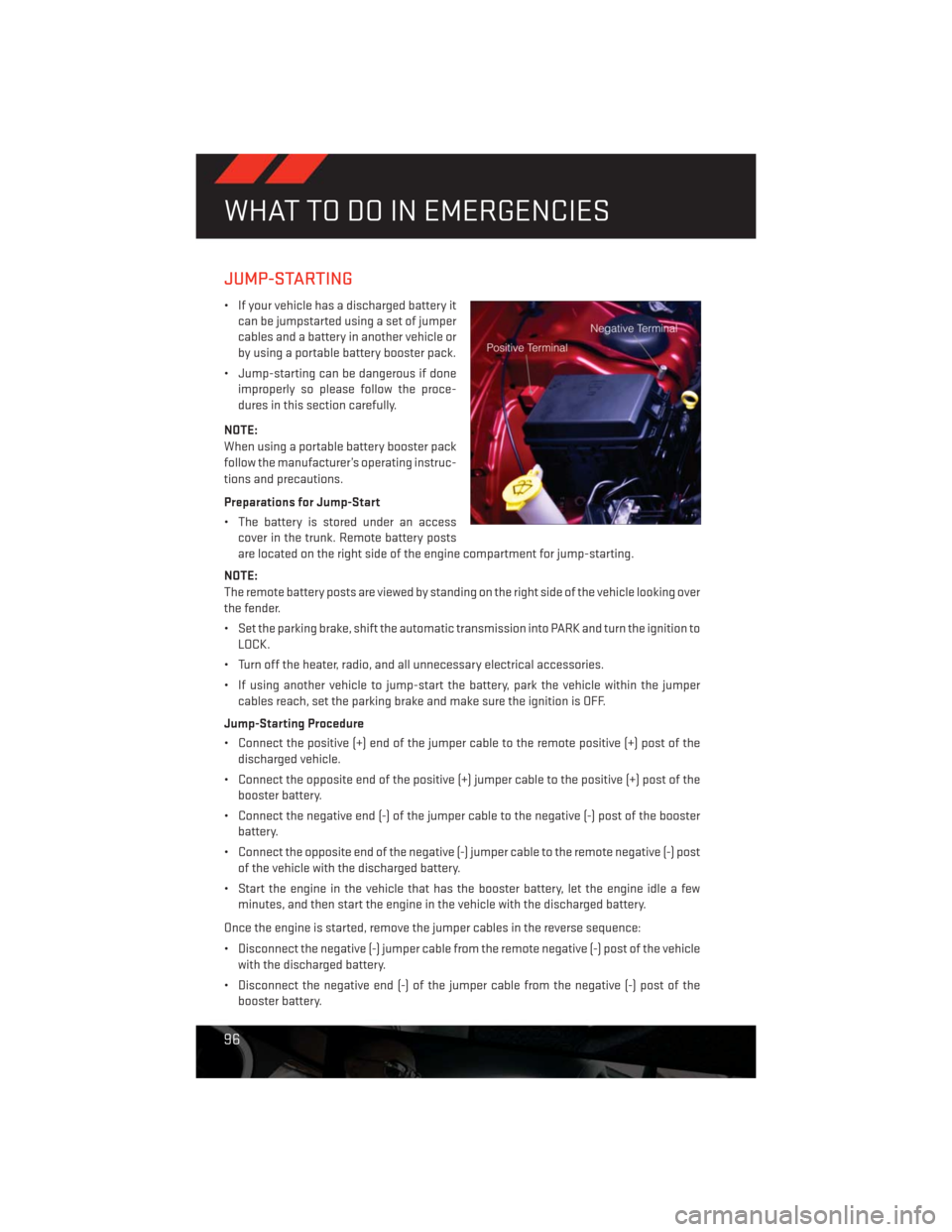
JUMP-STARTING
• If your vehicle has a discharged battery it
can be jumpstarted using a set of jumper
cables and a battery in another vehicle or
by using a portable battery booster pack.
• Jump-starting can be dangerous if done
improperly so please follow the proce-
dures in this section carefully.
NOTE:
When using a portable battery booster pack
follow the manufacturer’s operating instruc-
tions and precautions.
Preparations for Jump-Start
• The battery is stored under an access
cover in the trunk. Remote battery posts
are located on the right side of the engine compartment for jump-starting.
NOTE:
The remote battery posts are viewed by standing on the right side of the vehicle looking over
the fender.
• Set the parking brake, shift the automatic transmission into PARK and turn the ignition to
LOCK.
• Turn off the heater, radio, and all unnecessary electrical accessories.
• If using another vehicle to jump-start the battery, park the vehicle within the jumper
cables reach, set the parking brake and make sure the ignition is OFF.
Jump-Starting Procedure
• Connect the positive (+) end of the jumper cable to the remote positive (+) post of the
discharged vehicle.
• Connect the opposite end of the positive (+) jumper cable to the positive (+) post of the
booster battery.
• Connect the negative end (-) of the jumper cable to the negative (-) post of the booster
battery.
• Connect the opposite end of the negative (-) jumper cable to the remote negative (-) post
of the vehicle with the discharged battery.
• Start the engine in the vehicle that has the booster battery, let the engine idle a few
minutes, and then start the engine in the vehicle with the discharged battery.
Once the engine is started, remove the jumper cables in the reverse sequence:
• Disconnect the negative (-) jumper cable from the remote negative (-) post of the vehicle
with the discharged battery.
• Disconnect the negative end (-) of the jumper cable from the negative (-) post of the
booster battery.
WHAT TO DO IN EMERGENCIES
96
Page 101 of 140
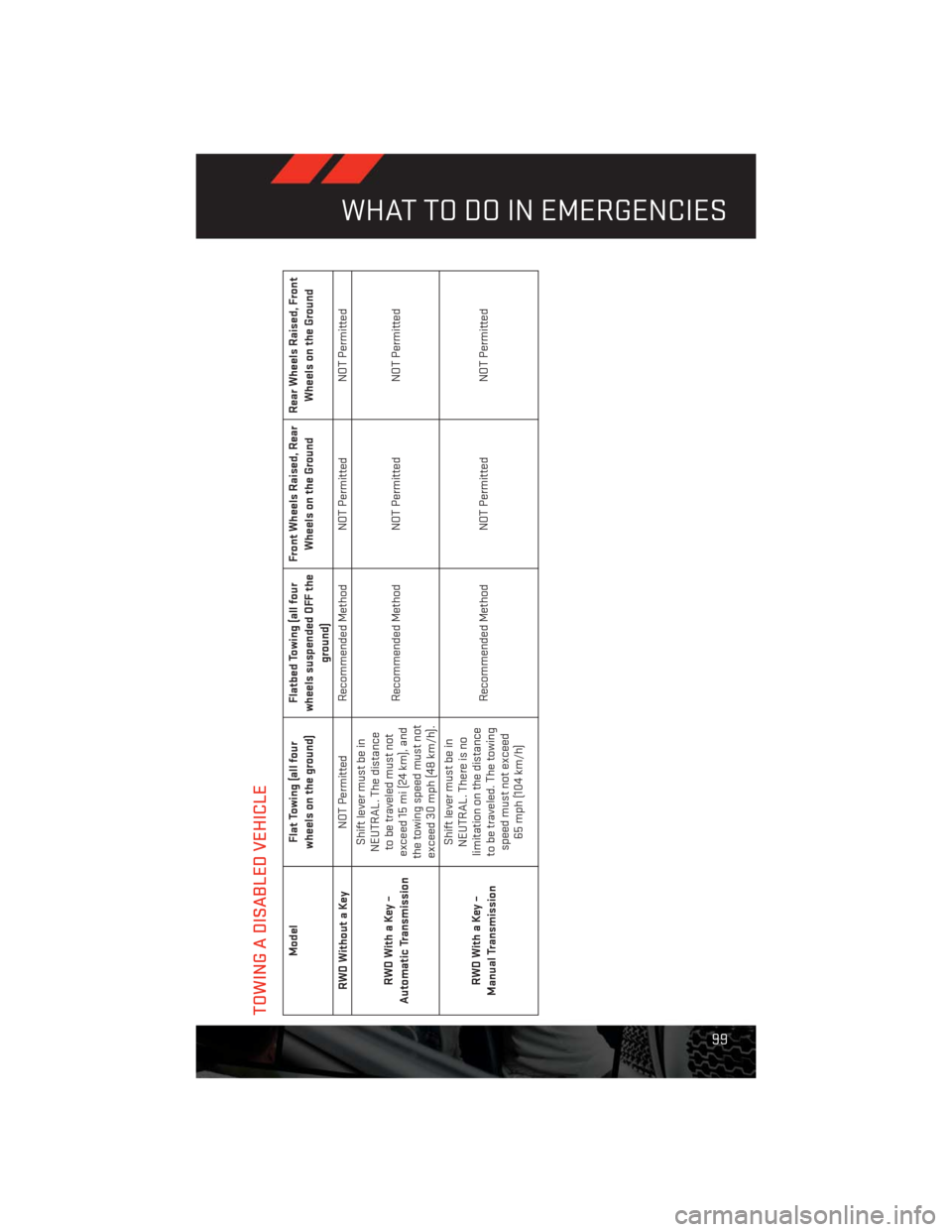
TOWING A DISABLED VEHICLE
Model Flat Towing (all four
wheels on the ground)Flatbed Towing (all four
wheels suspended OFF the
ground)Front Wheels Raised, Rear
Wheels on the GroundRear Wheels Raised, Front
Wheels on the Ground
RWDWithoutaKeyNOT Permitted Recommended Method NOT Permitted NOT Permitted
RWDWithaKey–
Automatic TransmissionShift lever must be in
NEUTRAL. The distance
to be traveled must not
exceed 15 mi (24 km), and
the towing speed must not
exceed 30 mph (48 km/h).Recommended Method NOT Permitted NOT Permitted
RWDWithaKey–
Manual TransmissionShift lever must be in
NEUTRAL. There is no
limitation on the distance
to be traveled. The towing
speed must not exceed
65 mph (104 km/h)Recommended Method NOT Permitted NOT Permitted
WHAT TO DO IN EMERGENCIES
99
Page 102 of 140
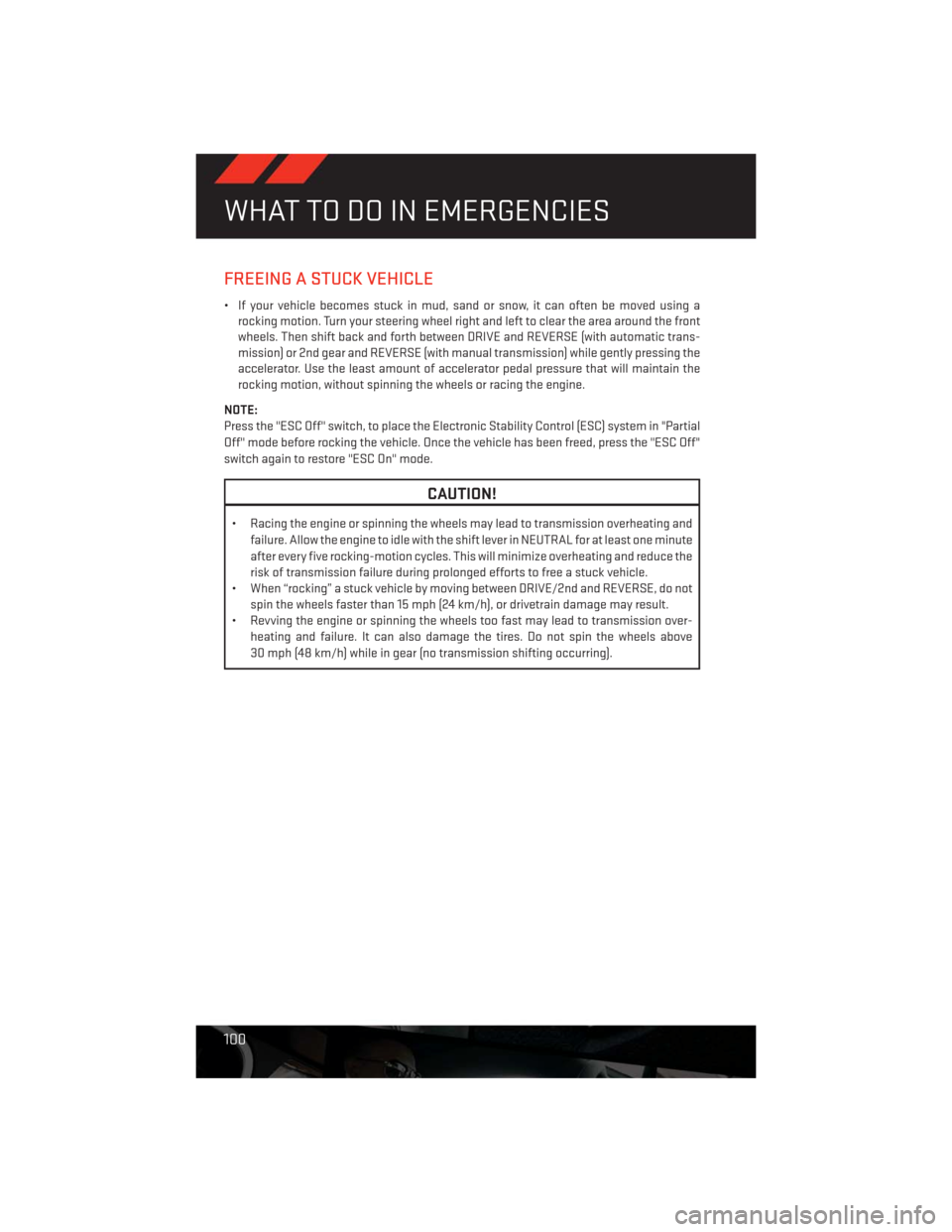
FREEING A STUCK VEHICLE
• If your vehicle becomes stuck in mud, sand or snow, it can often be moved using a
rocking motion. Turn your steering wheel right and left to clear the area around the front
wheels. Then shift back and forth between DRIVE and REVERSE (with automatic trans-
mission) or 2nd gear and REVERSE (with manual transmission) while gently pressing the
accelerator. Use the least amount of accelerator pedal pressure that will maintain the
rocking motion, without spinning the wheels or racing the engine.
NOTE:
Press the "ESC Off" switch, to place the Electronic Stability Control (ESC) system in "Partial
Off" mode before rocking the vehicle. Once the vehicle has been freed, press the "ESC Off"
switch again to restore "ESC On" mode.
CAUTION!
• Racing the engine or spinning the wheels may lead to transmission overheating and
failure. Allow the engine to idle with the shift lever in NEUTRAL for at least one minute
after every five rocking-motion cycles. This will minimize overheating and reduce the
risk of transmission failure during prolonged efforts to free a stuck vehicle.
• When “rocking” a stuck vehicle by moving between DRIVE/2nd and REVERSE, do not
spin the wheels faster than 15 mph (24 km/h), or drivetrain damage may result.
• Revving the engine or spinning the wheels too fast may lead to transmission over-
heating and failure. It can also damage the tires. Do not spin the wheels above
30 mph (48 km/h) while in gear (no transmission shifting occurring).
WHAT TO DO IN EMERGENCIES
100
Page 108 of 140
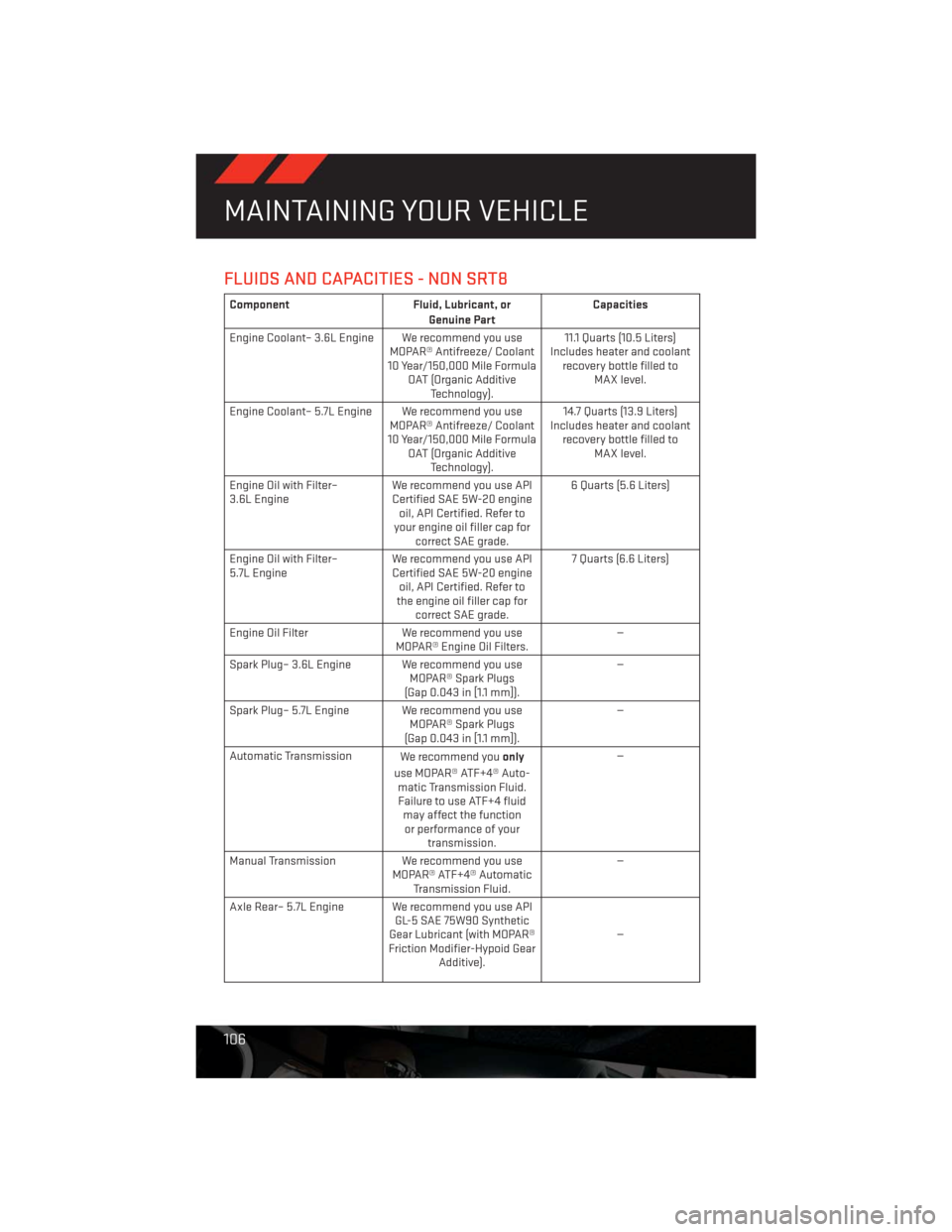
FLUIDS AND CAPACITIES - NON SRT8
Component Fluid, Lubricant, or
Genuine PartCapacities
Engine Coolant– 3.6L Engine We recommend you use
MOPAR® Antifreeze/ Coolant
10 Year/150,000 Mile Formula
OAT (Organic Additive
Technology).11.1 Quarts (10.5 Liters)
Includes heater and coolant
recovery bottle filled to
MAX level.
Engine Coolant– 5.7L Engine We recommend you use
MOPAR® Antifreeze/ Coolant
10 Year/150,000 Mile Formula
OAT (Organic Additive
Technology).14.7 Quarts (13.9 Liters)
Includes heater and coolant
recovery bottle filled to
MAX level.
Engine Oil with Filter–
3.6L EngineWe recommend you use API
Certified SAE 5W-20 engine
oil, API Certified. Refer to
your engine oil filler cap for
correct SAE grade.6 Quarts (5.6 Liters)
Engine Oil with Filter–
5.7L EngineWe recommend you use API
Certified SAE 5W-20 engine
oil, API Certified. Refer to
the engine oil filler cap for
correct SAE grade.7 Quarts (6.6 Liters)
Engine Oil Filter We recommend you use
MOPAR® Engine Oil Filters.—
Spark Plug– 3.6L Engine We recommend you use
MOPAR® Spark Plugs
(Gap 0.043 in [1.1 mm]).—
Spark Plug– 5.7L Engine We recommend you use
MOPAR® Spark Plugs
(Gap 0.043 in [1.1 mm]).—
Automatic Transmission
We recommend youonly
use MOPAR® ATF+4® Auto-
matic Transmission Fluid.
Failure to use ATF+4 fluid
may affect the function
or performance of your
transmission.—
Manual Transmission We recommend you use
MOPAR® ATF+4® Automatic
Transmission Fluid.—
Axle Rear– 5.7L Engine We recommend you use API
GL-5 SAE 75W90 Synthetic
Gear Lubricant (with MOPAR®
Friction Modifier-Hypoid Gear
Additive).—
MAINTAINING YOUR VEHICLE
106
Page 110 of 140
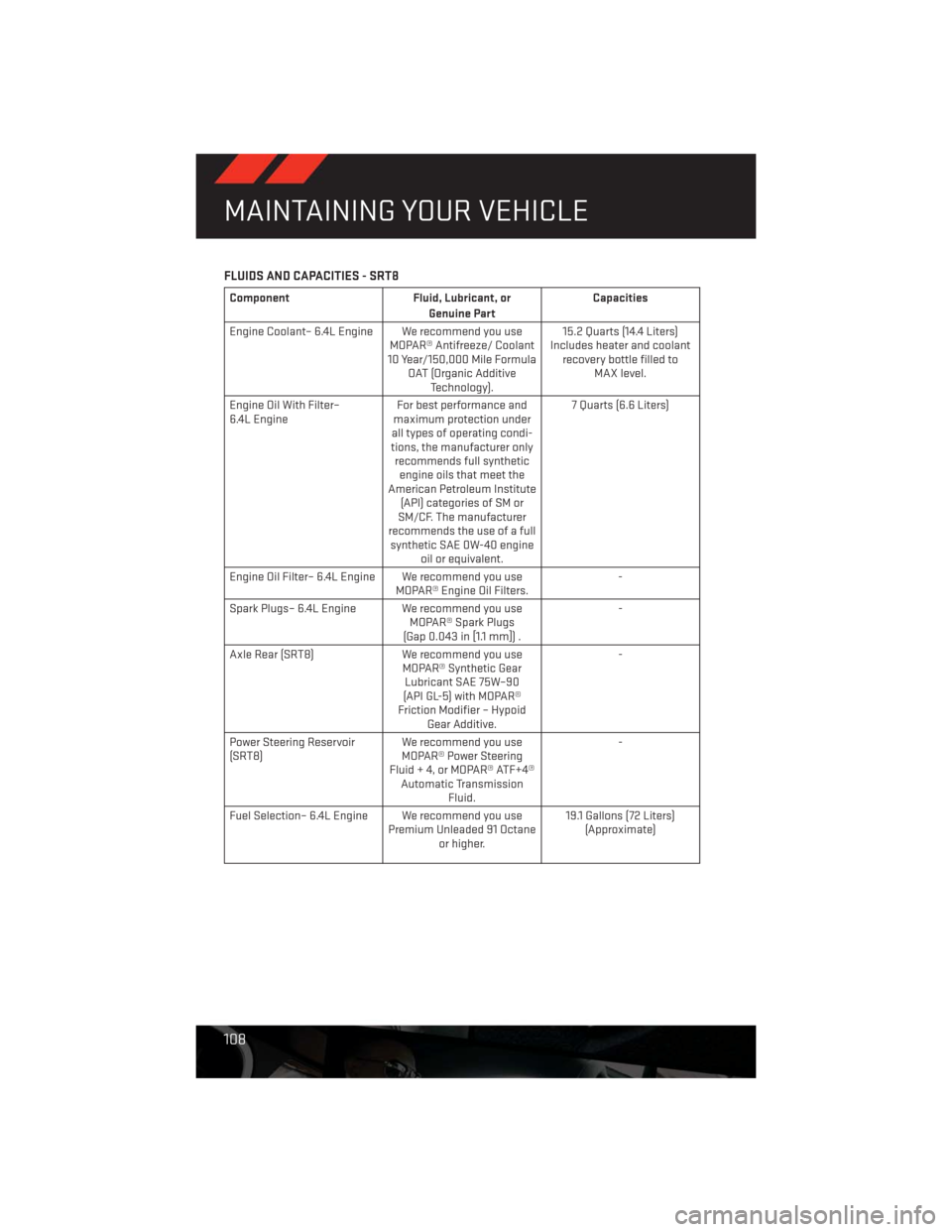
FLUIDS AND CAPACITIES - SRT8
Component Fluid, Lubricant, or
Genuine PartCapacities
Engine Coolant– 6.4L Engine We recommend you use
MOPAR® Antifreeze/ Coolant
10 Year/150,000 Mile Formula
OAT (Organic Additive
Technology).15.2 Quarts (14.4 Liters)
Includes heater and coolant
recovery bottle filled to
MAX level.
Engine Oil With Filter–
6.4L EngineFor best performance and
maximum protection under
all types of operating condi-
tions, the manufacturer only
recommends full synthetic
engine oils that meet the
American Petroleum Institute
(API) categories of SM or
SM/CF. The manufacturer
recommends the use of a full
synthetic SAE 0W-40 engine
oil or equivalent.7 Quarts (6.6 Liters)
Engine Oil Filter– 6.4L Engine We recommend you use
MOPAR® Engine Oil Filters.-
Spark Plugs– 6.4L Engine We recommend you use
MOPAR® Spark Plugs
(Gap 0.043 in [1.1 mm]) .-
Axle Rear (SRT8) We recommend you use
MOPAR® Synthetic Gear
Lubricant SAE 75W–90
(API GL-5) with MOPAR®
Friction Modifier – Hypoid
Gear Additive.-
Power Steering Reservoir
(SRT8)We recommend you use
MOPAR® Power Steering
Fluid + 4, or MOPAR® ATF+4®
Automatic Transmission
Fluid.-
Fuel Selection– 6.4L Engine We recommend you use
Premium Unleaded 91 Octane
or higher.19.1 Gallons (72 Liters)
(Approximate)
MAINTAINING YOUR VEHICLE
108
Page 111 of 140
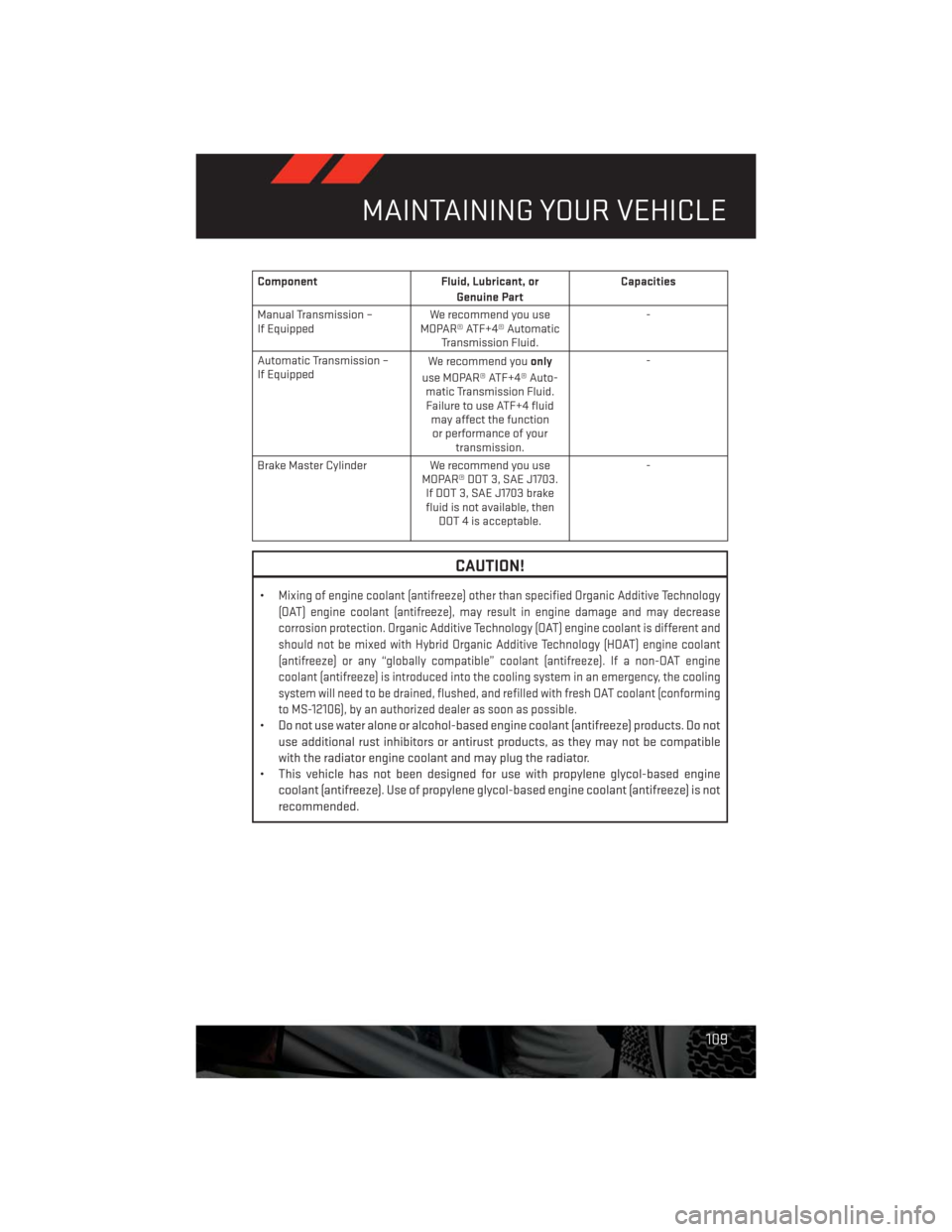
Component Fluid, Lubricant, or
Genuine PartCapacities
Manual Transmission –
If EquippedWe recommend you use
MOPAR® ATF+4® Automatic
Transmission Fluid.-
Automatic Transmission –
If EquippedWe recommend youonly
use MOPAR® ATF+4® Auto-
matic Transmission Fluid.
Failure to use ATF+4 fluid
may affect the function
or performance of your
transmission.-
Brake Master Cylinder We recommend you use
MOPAR® DOT 3, SAE J1703.
If DOT 3, SAE J1703 brake
fluid is not available, then
DOT 4 is acceptable.-
CAUTION!
•Mixing of engine coolant (antifreeze) other than specified Organic Additive Technology
(OAT) engine coolant (antifreeze), may result in engine damage and may decrease
corrosion protection. Organic Additive Technology (OAT) engine coolant is different and
should not be mixed with Hybrid Organic Additive Technology (HOAT) engine coolant
(antifreeze) or any “globally compatible” coolant (antifreeze). If a non-OAT engine
coolant (antifreeze) is introduced into the cooling system in an emergency, the cooling
system will need to be drained, flushed, and refilled with fresh OAT coolant (conforming
to MS-12106), by an authorized dealer as soon as possible.
• Do not use water alone or alcohol-based engine coolant (antifreeze) products. Do not
use additional rust inhibitors or antirust products, as they may not be compatible
with the radiator engine coolant and may plug the radiator.
• This vehicle has not been designed for use with propylene glycol-based engine
coolant (antifreeze). Use of propylene glycol-based engine coolant (antifreeze) is not
recommended.
MAINTAINING YOUR VEHICLE
109
Page 113 of 140
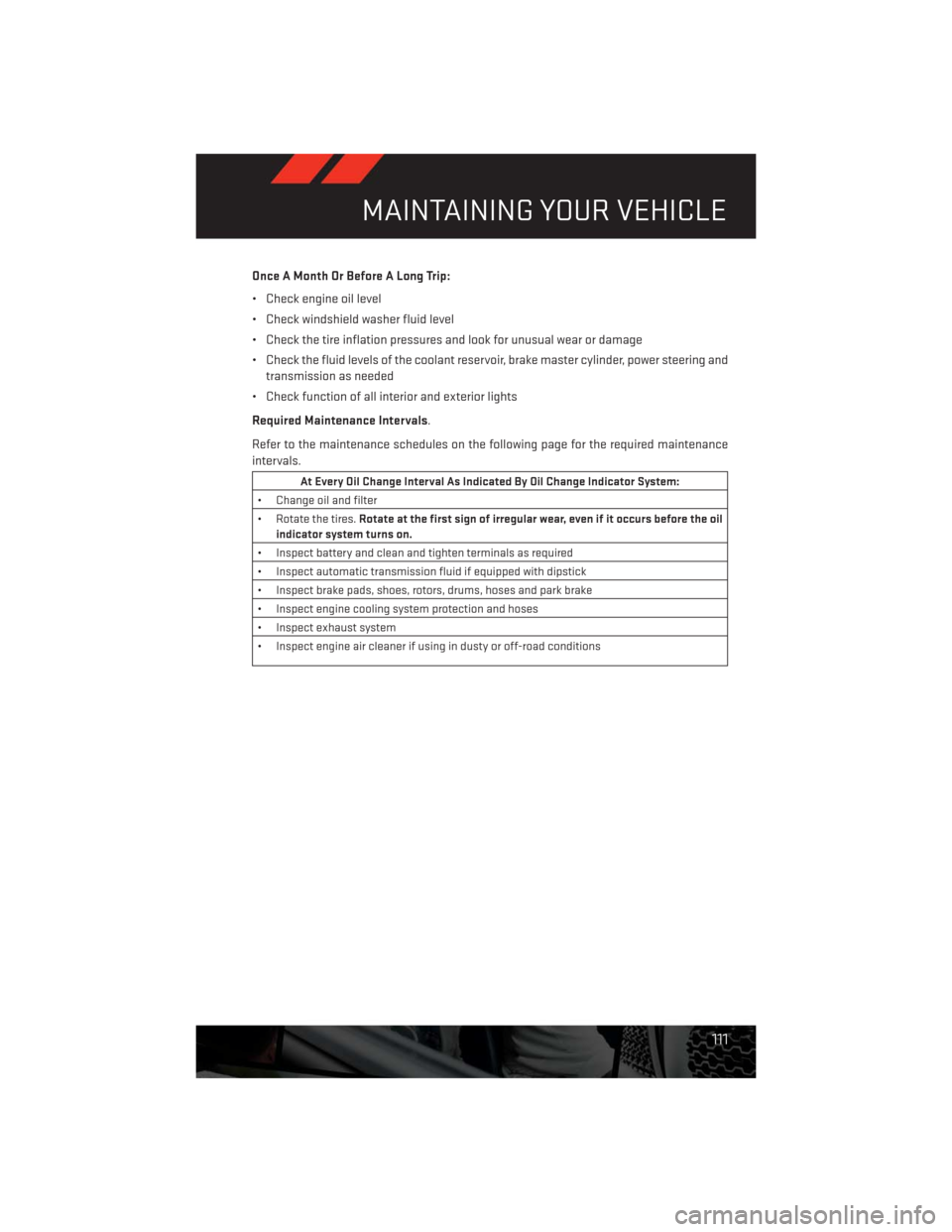
Once A Month Or Before A Long Trip:
• Check engine oil level
• Check windshield washer fluid level
• Check the tire inflation pressures and look for unusual wear or damage
• Check the fluid levels of the coolant reservoir, brake master cylinder, power steering and
transmission as needed
• Check function of all interior and exterior lights
Required Maintenance Intervals.
Refer to the maintenance schedules on the following page for the required maintenance
intervals.
At Every Oil Change Interval As Indicated By Oil Change Indicator System:
• Change oil and filter
• Rotate the tires.Rotate at the first sign of irregular wear, even if it occurs before the oil
indicator system turns on.
• Inspect battery and clean and tighten terminals as required
• Inspect automatic transmission fluid if equipped with dipstick
• Inspect brake pads, shoes, rotors, drums, hoses and park brake
• Inspect engine cooling system protection and hoses
• Inspect exhaust system
• Inspect engine air cleaner if using in dusty or off-road conditions
MAINTAINING YOUR VEHICLE
111
Page 115 of 140
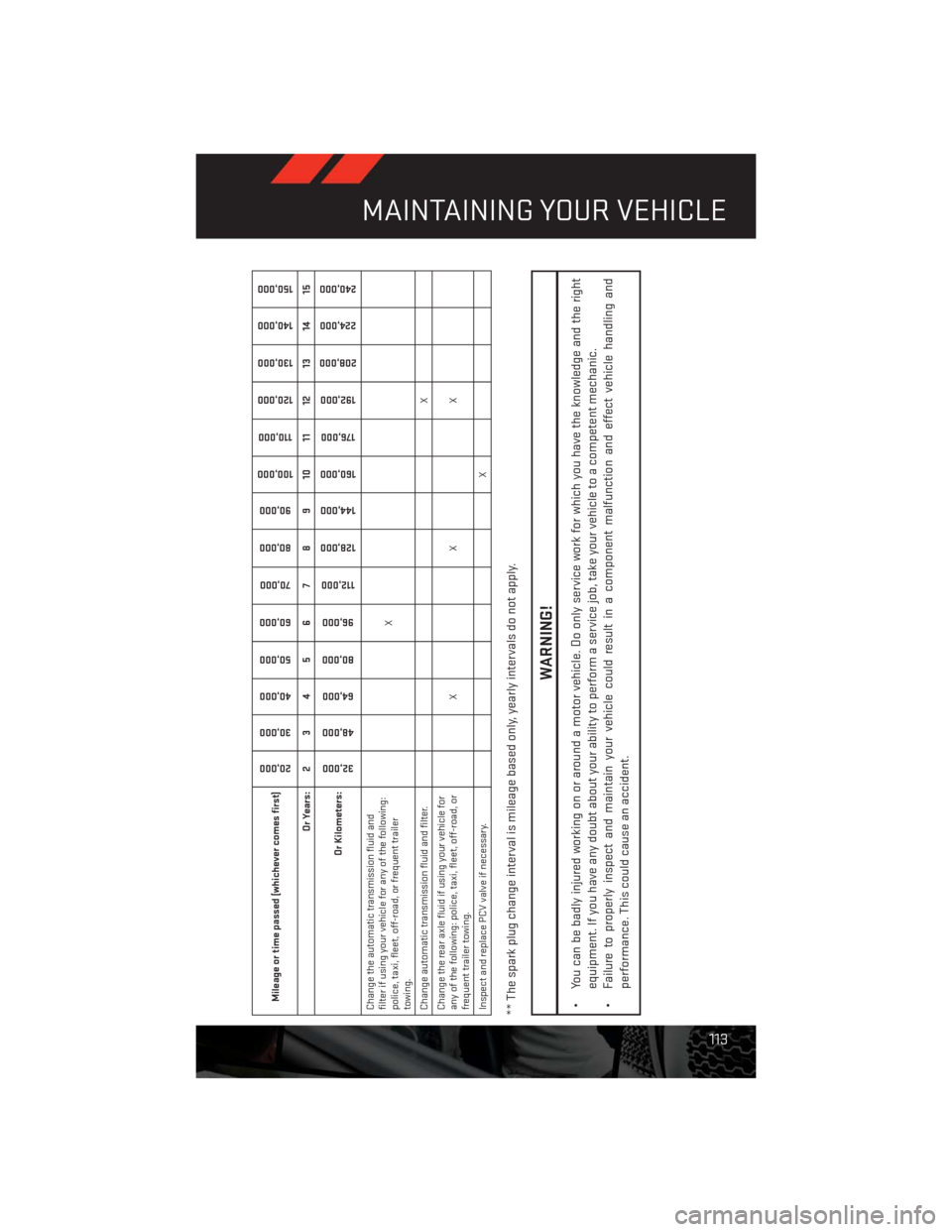
Mileage or time passed (whichever comes first)
20,000
30,000
40,000
50,000
60,000
70,000
80,000
90,000
100,000
110,000
120,000
130,000
140,000
150,000
Or Years: 2 3 4 5 6 7 8 9 10 11 12 13 14 15
Or Kilometers:
32,000
48,000
64,000
80,000
96,000
112,000
128,000
144,000
160,000
176,000
192,000
208,000
224,000
240,000
Change the automatic transmission fluid and
filter if using your vehicle for any of the following:
police, taxi, fleet, off-road, or frequent trailer
towing.X
Change automatic transmission fluid and filter.X
Change the rear axle fluid if using your vehicle for
any of the following: police, taxi, fleet, off-road, or
frequent trailer towing.XXX
Inspect and replace PCV valve if necessary.X** The spark plug change interval is mileage based only, yearly intervals do not apply.
WARNING!
• You can be badly injured working on or around a motor vehicle. Do only service work for which you have the knowledge and the right
equipment. If you have any doubt about your ability to perform a service job, take your vehicle to a competent mechanic.
• Failure to properly inspect and maintain your vehicle could result in a component malfunction and effect vehicle handling and
performance. This could cause an accident.
MAINTAINING YOUR VEHICLE
113
Page 117 of 140
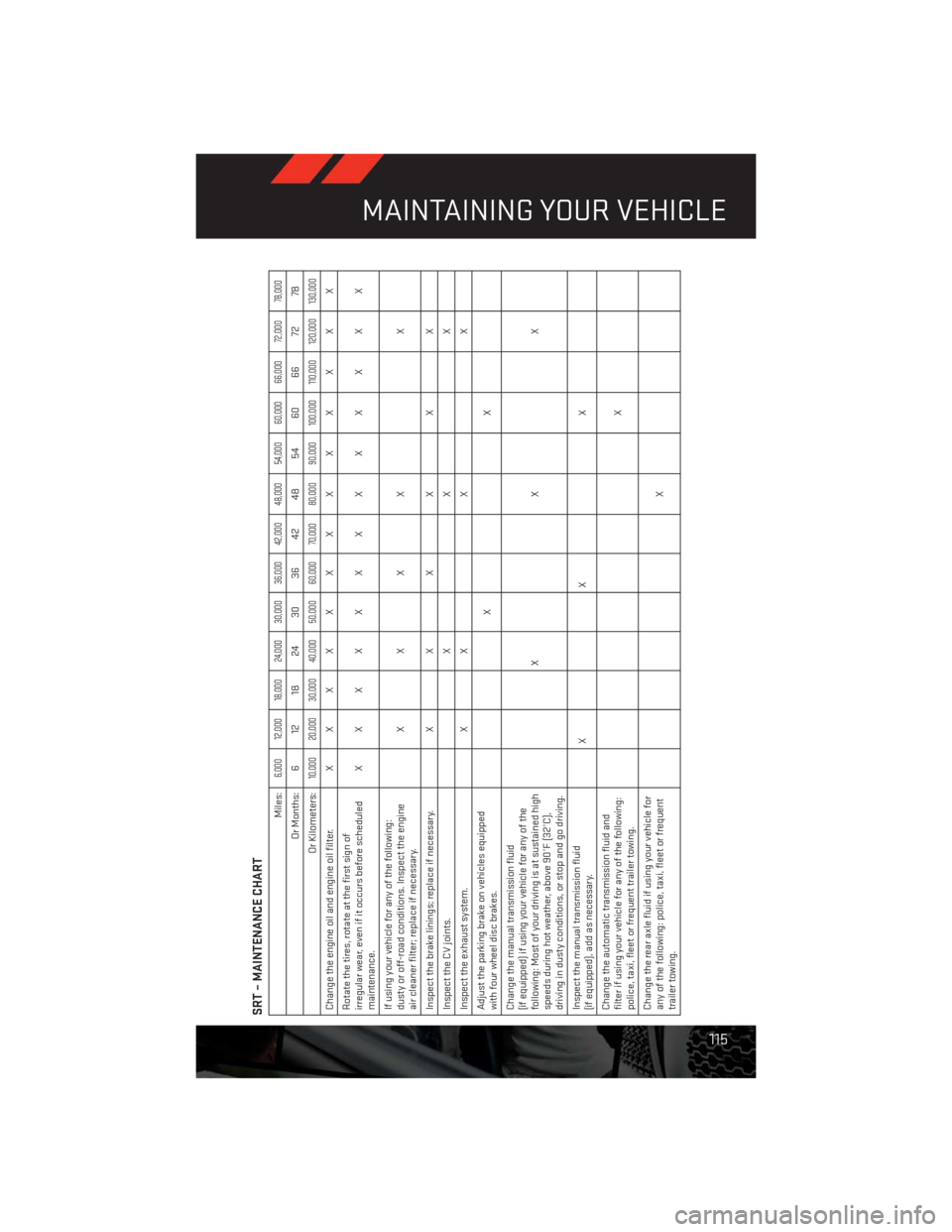
SRT – MAINTENANCE CHART
Miles:
6,000 12,000 18,000 24,000 30,000 36,000 42,000 48,000 54,000 60,000 66,000 72,000 78,000
Or Months: 6 12 18 24 30 36 42 48 54 60 66 72 78
Or Kilometers:
10,000 20,000 30,000 40,000 50,000 60,000 70,000 80,000 90,000 100,000 110,000 120,000 130,000
Change the engine oil and engine oil filter.XXXXXXX XXXXXX
Rotate the tires, rotate at the first sign of
irregular wear, even if it occurs before scheduled
maintenance.XXXXXXX XXXXXX
If using your vehicle for any of the following:
dusty or off-road conditions. Inspect the engine
air cleaner filter; replace if necessary.XXX X X
Inspect the brake linings; replace if necessary. X X X X X X
Inspect the CV joints. X X X
Inspect the exhaust system. X X X X
Adjust the parking brake on vehicles equipped
with four wheel disc brakes.XX
Change the manual transmission fluid
(if equipped) if using your vehicle for any of the
following: Most of your driving is at sustained high
speeds during hot weather, above 90°F (32°C),
driving in dusty conditions, or stop and go driving.XXX
Inspect the manual transmission fluid
(if equipped), add as necessary.XX X
Change the automatic transmission fluid and
filter if using your vehicle for any of the following:
police, taxi, fleet or frequent trailer towing.X
Change the rear axle fluid if using your vehicle for
any of the following: police, taxi, fleet or frequent
trailer towing.X
MAINTAINING YOUR VEHICLE
115
Page 128 of 140
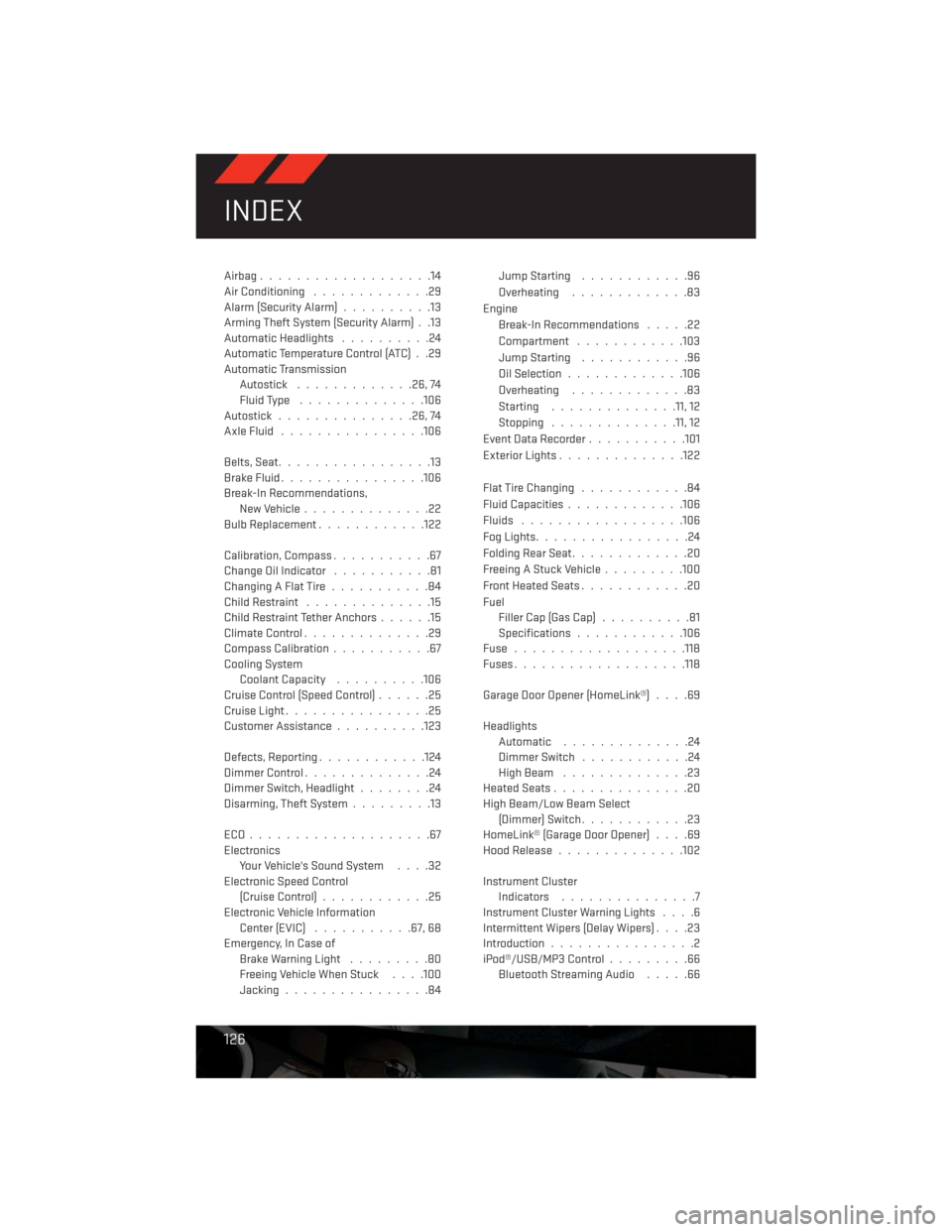
Airbag...................14
Air Conditioning.............29
Alarm (Security Alarm)..........13
Arming Theft System (Security Alarm) . .13
Automatic Headlights..........24
Automatic Temperature Control (ATC) . .29
Automatic Transmission
Autostick.............26,74
Fluid Type..............106
Autostick...............26,74
AxleFluid ................106
Belts, Seat.................13
BrakeFluid................106
Break-In Recommendations,
New Vehicle..............22
Bulb Replacement............122
Calibration, Compass...........67
Change Oil Indicator...........81
ChangingAFlatTire...........84
Child Restraint..............15
Child Restraint Tether Anchors......15
ClimateControl..............29
Compass Calibration...........67
Cooling System
Coolant Capacity..........106
Cruise Control (Speed Control)......25
Cruise Light................25
Customer Assistance..........123
Defects, Reporting............124
DimmerControl..............24
Dimmer Switch, Headlight........24
Disarming, Theft System.........13
ECO....................67
Electronics
Your Vehicle's Sound System....32
Electronic Speed Control
(Cruise Control)............25
Electronic Vehicle Information
Center(EVIC) ...........67, 68
Emergency, In Case of
Brake Warning Light.........80
Freeing Vehicle When Stuck. . . .100
Jacking................84JumpStarting ............96
Overheating.............83
Engine
Break-In Recommendations.....22
Compartment ............103
JumpStarting ............96
Oil Selection.............106
Overheating.............83
Starting..............11, 12
Stopping..............11, 12
Event Data Recorder...........101
Exterior Lights..............122
Flat Tire Changing............84
Fluid Capacities.............106
Fluids ..................106
FogLights.................24
Folding Rear Seat.............20
Freeing A Stuck Vehicle.........100
Front Heated Seats............20
Fuel
Filler Cap (Gas Cap)..........81
Specifications
............106
Fuse ...................118
Fuses...................118
Garage Door Opener (HomeLink®)....69
Headlights
Automatic ..............24
Dimmer Switch............24
HighBeam ..............23
Heated Seats...............20
High Beam/Low Beam Select
(Dimmer) Switch............23
HomeLink® (Garage Door Opener)....69
Hood Release..............102
Instrument Cluster
Indicators...............7
Instrument Cluster Warning Lights....6
Intermittent Wipers (Delay Wipers)....23
Introduction................2
iPod®/USB/MP3 Control.........66
Bluetooth Streaming Audio.....66
INDEX
126